The OCZ Octane Review (512GB)
by Anand Lal Shimpi on November 23, 2011 12:00 PM ESTRandom Read/Write Speed
The four corners of SSD performance are as follows: random read, random write, sequential read and sequential write speed. Random accesses are generally small in size, while sequential accesses tend to be larger and thus we have the four Iometer tests we use in all of our reviews.
Our first test writes 4KB in a completely random pattern over an 8GB space of the drive to simulate the sort of random access that you'd see on an OS drive (even this is more stressful than a normal desktop user would see). I perform three concurrent IOs and run the test for 3 minutes. The results reported are in average MB/s over the entire time. We use both standard pseudo randomly generated data for each write as well as fully random data to show you both the maximum and minimum performance offered by SandForce based drives in these tests. The average performance of SF drives will likely be somewhere in between the two values for each drive you see in the graphs. For an understanding of why this matters, read our original SandForce article.
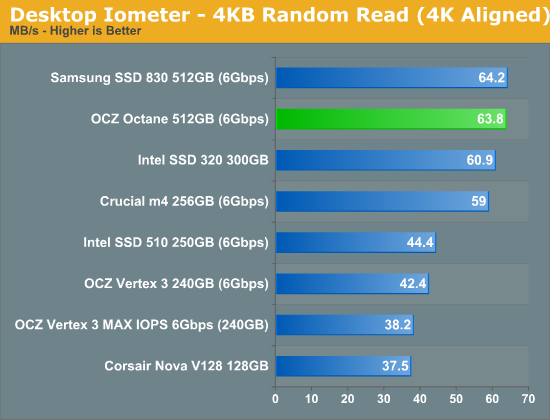
Random read performance is very good on the Octane, matching the Samsung SSD 830 and the Intel SSD 320. Random write performance is no where near as fast as the Samsung, Crucial or SF-2281 based drives, but as we've seen in the past this can be enough performance for a desktop workload.
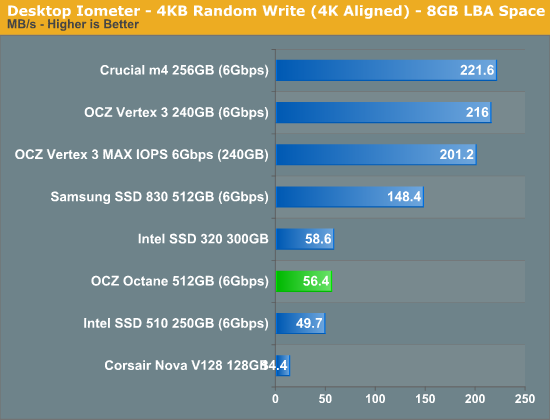
Many of you have asked for random write performance at higher queue depths. What I have below is our 4KB random write test performed at a queue depth of 32 instead of 3. While the vast majority of desktop usage models experience queue depths of 0 - 5, higher depths are possible in heavy I/O (and multi-user) workloads:
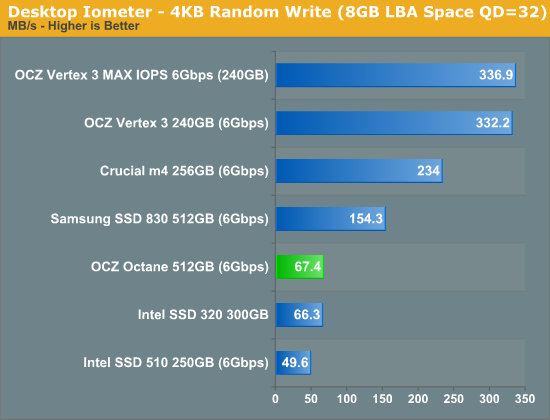
Random write performance at higher queue depths doesn't scale nearly as well as the SandForce based drives. This doesn't really matter for desktop users, but I am curious to see how OCZ will position Everest in the enterprise space against SandForce. Perhaps that's where OCZ will focus its SandForce efforts instead and leave the consumer market to Indilinx.
Sequential Read/Write Speed
To measure sequential performance I ran a 1 minute long 128KB sequential test over the entire span of the drive at a queue depth of 1. The results reported are in average MB/s over the entire test length.
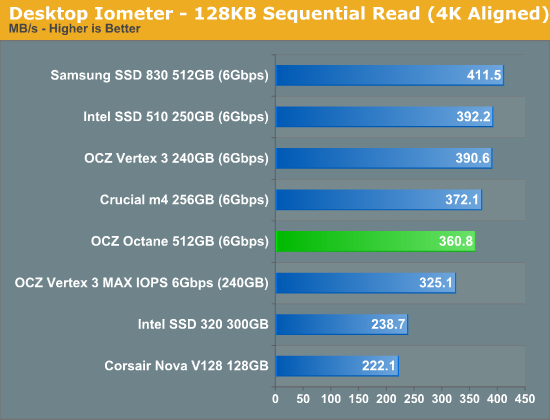
Sequential read and write performance is competitive, but not class leading. The Octane effectively performs like a Crucial m4 here, which isn't bad considering the m4 is a far more mature platform.
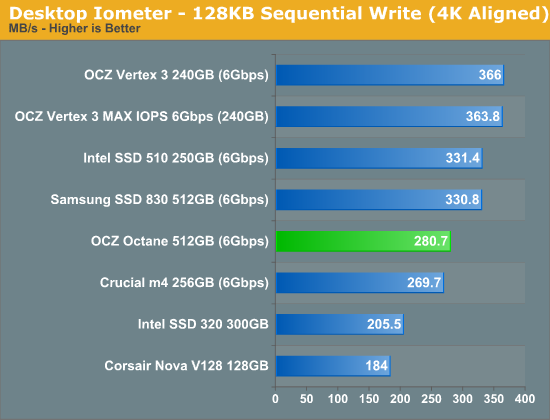










75 Comments
View All Comments
jwilliams4200 - Wednesday, November 23, 2011 - link
"OCZ sent us a 512GB version with sixteen NAND packages and four 8GB die per package. We typically don't see any interleaving benefits beyond two die per package, so I'd expect similar performance between the 512GB drive and the 256GB version (despite the significant difference in specs)"What a strange thing to say. Do you really mean that you think that despite OCZ quoting a 270MB/s sequential write speed for the 256GB model (vs. 400MB/s for the 512GB model), that the two sizes will actually have the same sequential write speed?
If so, I'd be willing to be a lot of money with you that you are wrong.
jwilliams4200 - Wednesday, November 23, 2011 - link
be -> betAnand Lal Shimpi - Wednesday, November 23, 2011 - link
The only reason I said that is because I wasn't really able to hit OCZ's "400MB/s" in our Iometer tests. Instead I got 280MB/s, which is closer to what OCZ specs the 256GB version at.I'm 100% ok with being wrong and I'll be sure to point it out if I am in the next review :)
Take care,
Anand
jwilliams4200 - Wednesday, November 23, 2011 - link
But you measured 395 MB/s for the 512GB Octane sequential write with AS-SSD.It seems that the Octane sequential write speed varies a lot (other review sites have measured 348 MB/s with AS-SSD). Maybe it depends a lot on the block size, or on the size of the test file (span), or on whether the SSD is in a used or fresh state.
Anand Lal Shimpi - Wednesday, November 23, 2011 - link
But if you look at HDTach and Iometer the perf is down at 280MB/s. I'm not entirely sure what's going on with AS-SSD...Take care,
Anand
gevorg - Wednesday, November 23, 2011 - link
"I believe OCZ needs a good 12 months of an Intel or Samsung-like track record to really build confidence in its products."I completely agree!!
LoneWolf15 - Thursday, November 24, 2011 - link
""I believe OCZ needs a good 12 months of an Intel or Samsung-like track record to really build confidence in its products."I completely agree!! "
That makes three of us. I'll say one more --they also need to build a proven track record of customer service as well.
Right now, Intel, Crucial (specifically the m4), and Samsung are the choices I look at if a client needs an SSD.
MrSpadge - Wednesday, November 23, 2011 - link
What's this "double write endurance" and "faster boot" about?MrS
iwod - Wednesday, November 23, 2011 - link
I think it just shows how Random Read is EXTREMELY important to Real world workloads.Since we have already establish Random Write over 40 - 50MB/s doesn't make any difference, And Seq Read Write matter a lot less then Random Read.
Taft12 - Wednesday, November 23, 2011 - link
Fully agree here, in fact random read is the only thing that really matters as far as anything you'd ever notice in real world desktop use.Anything more is benchmark porn (no offense to the fetishes of many AT readers)
Longevity and stability is most important by far, too bad a benchmark can't determine that.